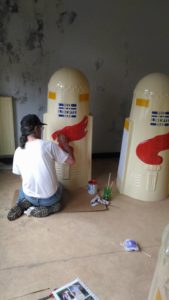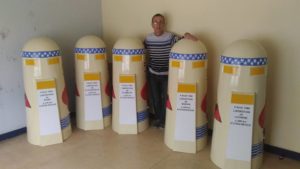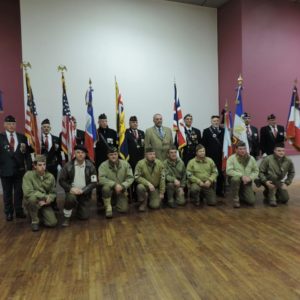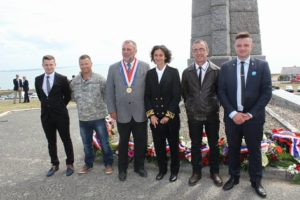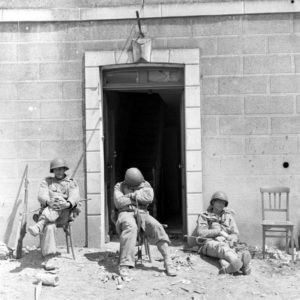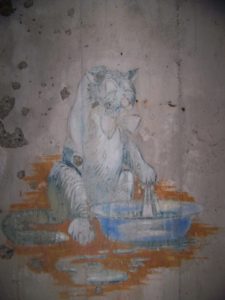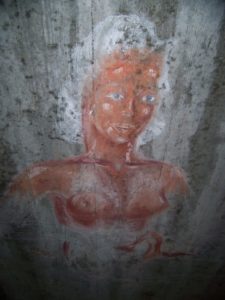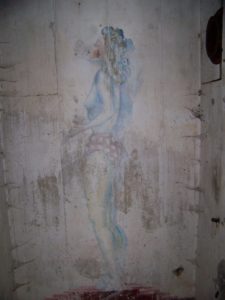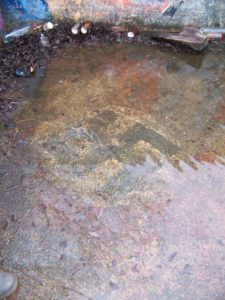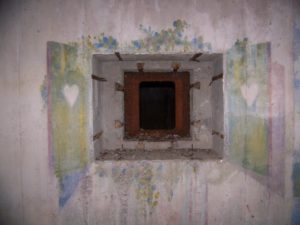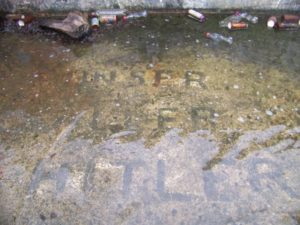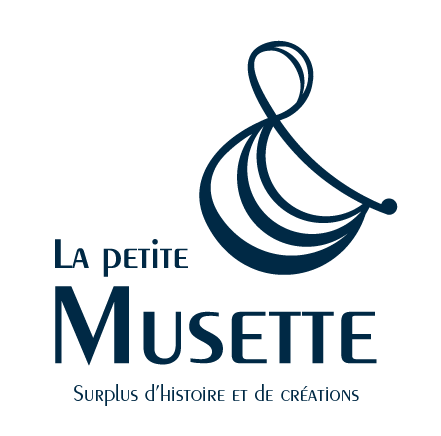by Bertrand Froger | 5 Sep 2017 | Celebrations, Places, To be visited, WW2 News
Liberation road markers… in Britain!
The initiative of Jacky Cadoux is not the least. Inspired by the Road markers of Liberty established on our territory from Normandy to the Belgian Ardennes, this enthusiast realizes the project to erect on 5 Breton municipalities of the Bornes of the Liberation retracing the course of the 4th American Armored Division on this sector. The communes selected and participating in the project are Plumelec, St Jean Brevelay, Bignan, Locmine and Baud. These monuments will be placed this week and inaugurated on October 28, 2017 starting with that of Plumelec (56420) at 9:30 am!
And so many others projects!
Jacky Cadoux is also president and a very active member of the association Souvenir Militaire Center Morbihan which aims to perpetuate the Remembrance and the Memory of the military facts carried out in Brittany during the XXth century. The club is organizing its 3rd Military Antiquities Fair, which will take place on November 12nd in Locminé (56) (Halle des Sports, Rue de la Bouillerie), which will enable the association to finance other commemorative and memorial projects.
More informations on the page of the association:
Souvenir Militaire Centre Morbihan
(Credits photos : Jacky Cadoux, Souvenir Militaire Centre Morbihan)
by Bertrand Froger | 22 Jun 2017 | Anecdotes, Places, To be visited
The streets of Carentan, witnesses of another time.
These three elements of the 327th Glider Regiment allow a moment of rest during the occupation of the city of Carentan following the liberation of the town. Landed on Utah Beach mainly on June 7th, 1944, this unit was originally intended to invade the land by gliders. It is an integral part of the 101st Airborne Division, which does not only include paratroopers. Men wear similar equipment, such as the famous US M1 rifle in its foldable butt version.
The Liberty Road, place where a lot of photos were taken.
But these elements of the 327th GIR were resting against the gable of a house are not alone and if you turn in the street, other soldiers also poke a nap. The third photo identifies this zoom. The Désiré Ingouf Café no longer exists and a new building, more or less similar has pushed in its place. However, the windows leave no doubt about the location of this snapshot. In addition, the color circles will allow you to locate yourself.
by Bertrand Froger | 9 Jun 2017 | Celebrations, Places, To be visited, WW2 News
An inauguration in grand manner
On Monday, June 5th, 2017, more than 300 people gathered to inaugurate the new stele in honor of Major John E. Tucker on the bridge between Carentan and Saint-Hilaire-Petitville. In order to unveil this block of granite where are reproductions of the 1944’s steles and emblem of the American corps of engineers, many civil and military authorities have made the displacement. Among them: Mister Lhonneur, Mayor and President of the community of communes of Carentan-les-Marais; Mr. Fauny, Mayor of Saint-Hilaire-Petitville; George K. Mullins, veteran of the 101st Airborne Division, General Glenn Goddard, elected officials, orchestra, US Army with color guard … A ceremony punctuated with moving speeches at the height of the event.
The culmination of a memorial project
It was in 2016 that Bertrand Froger launched a call from his Facebook page (Normandy 1944, Follow the Guide!), Affected by the disappearance of the stelae in homage to Major Tucker killed in action in June 1944. They had been implanted following his death by his men of the 300th Engineer Combat Battalion and citizens of the area. The project is taking shape, supported by the two municipalities, and then a participatory fundraising campaign is launched. Hundreds of people relay this action, dozens contribute, individuals and associations. The objective is achieved and the funds raised. On June 5th, 2017, Major Tucker’s honor is safe and his memory preserved and honored.
by Bertrand Froger | 29 May 2017 | Celebrations, Places, To be visited
Memorial Day, history of a celebration.
At the end of the Civil War, it was customary for the graves of the fallen American soldiers to be covered with flowers on a particular annual date. On May 5th, 1868, this day became a holiday of the calendar. On May 30th, 1868, it was named “Decoration Day” and celebrated at the Arlington National Cemetery. In 1882, it was renamed “Memorial Day” to celebrate all the dead in combat of all the wars involving American soldiers and not only those killed during the American Civil War. In 1967, Memorial Day extended to the federal level and a year later, the Congress adopted the Uniform Monday Holiday Act, moving that day to the last Monday in May, to propose a three-day weekend. This Act comes into force on January 1st, 1971.
Memorial Day at Brittany American Cemetery
At 4 pm on May 28th, 2917, several hundred people gathered at the Brittany American Cemetery in St-James (St. James -50) to commemorate Memorial Day and to gather on the graves of these young liberators buried in these places. This annual ceremony in the presence of Franco-American civilian and military authorities was also marked by the arrival of veterans John Roman and Charles Chay, the opportunity to greet them and thank them for their service. 73 years later, the people of France have not forgotten the sacrifice of these young men who came from the other side of the Atlantic.
by Bertrand Froger | 22 May 2017 | Collections, Places, To be visited, WW2 News
European night of the Museums
Annual and unconditional event for all those animated by cultural passion, the Night of Museums is an event not to be missed. Indeed, one evening in the year and all over the continent, the sites that wish to open their doors free, at reduced rates, while proposing many animations. The opportunity to visit a museum, a battery of artillery or any other memorial in a particular context and arousing an additional interest for the discovery of a place but in an environment changing from that habitual.
Visit of the Airborne Museum
On the occasion of the European Night of Museums, the Airborne Museum of Sainte-Mère-Eglise opened its doors until 11 pm last night. A varied program was proposed to visitors: a complete night tour of the site including the new temporary exhibition dedicated to Bastogne, embarkation and guided tour of the C-47 Argonia, plays offered by schoolchildren on the Normandy landing. It was the opportunity to enjoy the beauty of a site constantly evolving in a different atmosphere.
by Bertrand Froger | 5 Apr 2017 | Discoveries, Places, To be visited
A fortified battery at the East of Cherbourg
It is in the North Cotentin a battery delivered to its own fate. Indeed, the Osteck point of defense, located in Carneville (Manche – 50), an important complex of dozens of concrete buildings of all types, commanded in 1944 by Major Kuppers, was the stronghold of the defense of Cherbourg. From now on, the site, invaded by the vegetation and sadly dilapidated, is far from attracting crowds of tourists. Yet, more than 70 years ago, hundreds of occupants left a memory of their passage.
The wall frescoes of Osteck
The years have passed and the more we advance in time and these memories of time will disappear. Inside the blockhouses, but also under your feet, on concrete slabs covered with moss, it is possible to discover all these paintings made by the German soldiers who occupied the premises during the Second World War. There are memories of the country, moments of joy and relaxation, but also symbols like the woman and her beauty or drawings reminiscent of the regime in place. It is a question of killing time for these soldiers, who remain men first and foremost, not all artists, but all awaiting a landing that is becoming more and more certain. The site will also fall into the hands of the Allies on June 26th, 1944.



